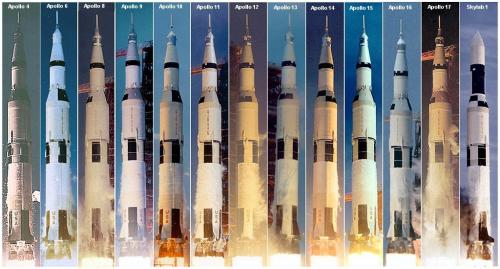Saturn V Rocket
Saturn V rockets were used by NASA between 1967 and 1973. It is a 'human rated expendable rocket', which means that it is safe to use for human spaceflight. The rocket design was developed for the Apollo missions that landed humans to the Moon. A Saturn V rocket was also used to launch Skylab. All 13 Saturn V launches from Kennedy Space Center in Florida were successful with no loss of crew or cargo.

Credit: Maldoror/NASA
Some facts about the Saturn V rocket:
- Height: 110.6 m
- Diameter: 10.1 m
- Mass: 2,970,000 kg
As of 2021, Saturn V is still the tallest, heaviest, and most powerful rocket ever used. It launched the heaviest ever object into orbit around the Earth - 140,000 kg for an Apollo mission. Saturn V is the only rocket to carry humans beyond a low Earth orbit. Between 1968 and 1972 a total of 24 astronauts were launched to the Moon by Saturn V rockets,
The rocket consists of three stages which each contains a rocket engine and fuel. The first stage uses kerosene rocket fuel, and the second and third stages use liquid hydrogen. The three stages stack on top of each other, with the first stage at the bottom of the rocket, and the third stage at the top. All together, the Saturn V rocket is 18 m taller than the Statue of Liberty, and 15 m taller than the Big Ben clock tower!

